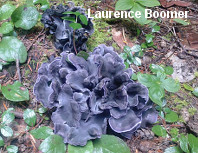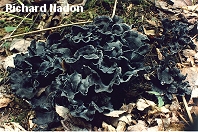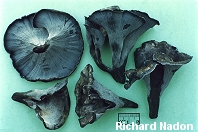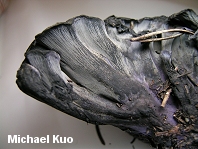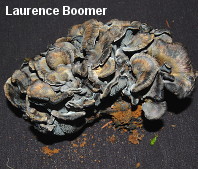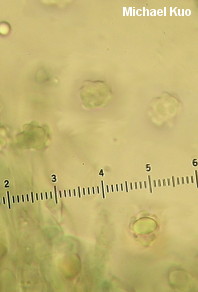| Major Groups > Chanterelles and Trumpets > Polyozellus multiplex |

|
Polyozellus multiplex [ Basidiomycota > Thelephorales > Thelephoraceae > Polyozellus . . . ] by Michael Kuo Though it is sometimes called the "blue chanterelle" in field guides, this funky mushroom does not fit very well into the genus Cantharellus; mycologists currently place it in its own genus, Polyozellus, in the Thelephoraceae. Polyozellus multiplex is an inhabitant of low, wet spruce and fir forests in northern and montane North America; it usually grows in clusters (which can measure up to one meter across, according to some sources) and can be recognized by its dark, purplish to bluish black colors and the brittle-fleshed, vase-shaped individual fruiting bodies. Thanks to Laurence Boomer for collecting, documenting, and preserving Polyozellus multiplex for study; his collection is deposited in The Herbarium of Michael Kuo. Description: Ecology: Mycorrhizal with conifers--especially spruces and firs--in low, wet areas; usually growing in dense, fused clusters; northern and montane North America (from the Pacific Northwest to Maine, and in the Rocky Mountains); summer and fall. The illustrated and described collections are from Oregon, Colorado, and Québec. Individual Caps: 2-8 cm wide; more or less round in outline, or irregularly shaped; finely velvety; purple to blue or black; sometimes faintly zoned concentrically, at least texturally; with a wavy margin that is initially whitish but darkens with maturity. Undersurface: Running down the stem; smooth to wrinkled, or sometimes with gill-like folds (occasionally nearly poroid in places); colored like the cap or paler; blackening with age. Stem: 2-4 cm long; 0.5-1.5 cm thick; colored like the undersurface; fused with other stems at the base; solid or becoming hollow. Flesh: Deep purple to bluish; soft but brittle. Odor and Taste: Odor fragrant; taste mild. Chemical Reactions: KOH green on flesh. Spore Print: White. Microscopic Features: Spores 6-8 x 5-7 µ; irregular in outline; nodulose, with 6-10 nodules visible per side; nodules about REFERENCES: (Underwood, 1899) Murrill, 1910. (Saccardo, 1902; Smith & Morse, 1947; Smith, 1949; Imazeki, 1953; Bigelow, 1978; Smith, Smith & Weber, 1981; Thiers, 1985; Arora, 1986; Lincoff, 1992; Stalpers, 1993; Barron, 1999; Pilz et al., 2003; Miller & Miller, 2006; Trudell & Ammirati, 2009.) Herb. Kuo 09051302. This site contains no information about the edibility or toxicity of mushrooms. |
© MushroomExpert.Com |
|
Cite this page as: Kuo, M. (2015, February). Polyozellus multiplex. Retrieved from the MushroomExpert.Com Web site: http://www.mushroomexpert.com/polyozellus_multiplex.html |
